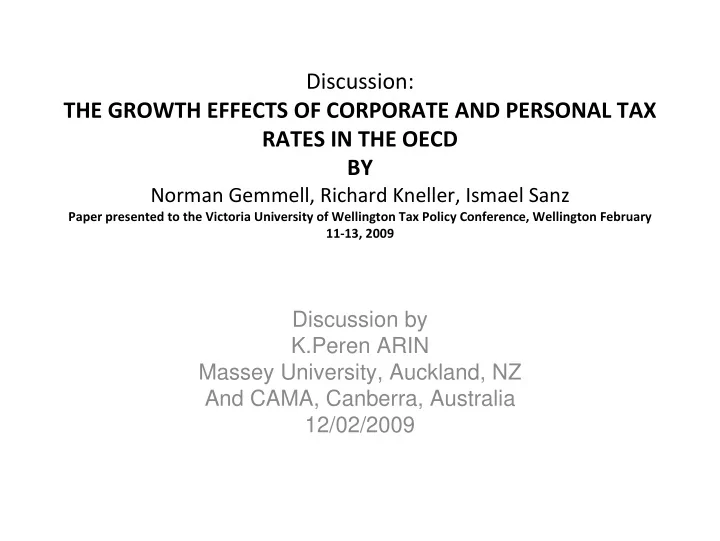

Discussion: THE GROWTH EFFECTS OF CORPORATE AND PERSONAL TAX RATES IN THE OECD BY Norman Gemmell, Richard Kneller, Ismael Sanz Paper presented to the Victoria University of Wellington Tax Policy Conference, Wellington February 11 ‐ 13, 2009 Discussion by K.Peren ARIN Massey University, Auckland, NZ And CAMA, Canberra, Australia 12/02/2009
Motivation • Every policymaker is interested in knowing the timing and the magnitude of his/her actions • There is no academic consensus about the effects of fiscal policy on growth – Theory: No effect (Neo ‐ classical growth theory), some taxes are harmful (Endogenous growth models, RBC models) – Empirics: Taxes are not harmful (Mendoza et.al, 1999) Income and Corporate Taxes are harmful (Kneller et. al. 1997), only Corporate Taxes are harmful (Lee and Gordon, 2005)
Gemmell et.al (2009) offers two explanations for the scant and mixed evidence: • Identifying tax policy changes: – Average tax rates (Tax Revenue/GDP, as suggested by Kneller et.al , 1999) – Top marginal tax rates (as suggested by Lee and Gordon, 2005) – Calculated marginal tax rates Myles (2007) argues: “ What the regressions end up using is an aggregate average rate, or constructed marginal rate, that probably does not affect the rate that any particular economic decision maker is facing.” • Relevance of foreign tax rates: – Previous studies may be plagued by an omitted variable bias, as corporate taxes work through international competition
...and they find that: • higher marginal rates of personal income tax (as measured by the top personal rate) are harmful for growth • both domestic and foreign corporate tax rates (statutory and/or effective), have affected growth rates in OECD • More specifically, evidence suggests that ‘bucking the OECD trend’ towards lower corporate tax rates is likely to be growth ‐ retarding, but joining it is likely to be growth ‐ neutral.
General Comments • A giant step towards understanding the long ‐ term effects of tax policy • Superbly well written paper on a timely and important topic • A solid empirical execution based on theoretical foundations
Can there be other explanations ? • Model Uncertainty (Sala ‐ i ‐ Martin, 1997) – If we had put average, top marginal, calculated marginal, and effective tax rates in a “horserace”, which tax measures would come on top? – Given the fact that different tax measures are important for different economic decisions, how justified is using those measures separately? – Although the authors base their empirical predictions on solid theoretical foundations, can we be sure that the theoretical model used gives us the “true” empirical model? – All of the above criticisms point out to potential benefits from using Bayesian Model Averaging (BMA) methodology
Can there be other explanations? (2) • Non ‐ linearities (Adam and Bevan, 2004) – It is a well ‐ known fact that budget deficits up to a certain threshold (1.5%) are not harmful for economic growth, but budget deficits above that critical threshold are harmful. – It is also reasonable to expect that a “critical threshold” exists for tax variables – What if there are “different growth regimes” exists below and above those critical thresholds? • All of the above criticisms point out to potential benefits from using Hansen data splitting methodology (2000)
Can there be other explanations? (3) • error structure – Serial correlation – Cross ‐ sectional correlation – Spatial correlation : seems to be the most important one, given the evidence provided by the paper. – The above criticisms point out to potential benefits from using some spatial econometrics
On a side note... • While a full treatment of all these issues is a mammoth task, all of these suggestions might gives further avenues of research. • One suggestion, however, seems very applicable in the short ‐ term: the paper, in its current version does not distinguish the effects of higher taxation and higher tax progressivity. Adding a progressivity measure as a control variable, might really help!
Other comments • What really “matters” in most macroeconomic models is Average Marginal Tax Rates (AMTRs) – AMTRs have been previously calculated for the U.S. And the U.K. – It might be an interesting exercise to see which previously mentioned tax measures have the highest pairwise correlations with the AMTRs – AMTRs for the US are presented below
Other comments (2) • One could check the importance of cyclicality by using cyclically adjusted taxes as a percentage of potential output (Alesina et.al., 2002) • One could check the timing of these effects by calculating Impulse response functions (IRFs) within a Panel VAR setting • One could check the stationarity of the panel for an empirical testing of convergence within OECD (Omay and Ucar, 2008)
Recommend
More recommend